The Spectral Computed Tomography Market is estimated to be valued at USD 9.4 billion in 2025 and is projected to reach USD 18.1 billion by 2035, registering a compound annual growth rate (CAGR) of 6.8% over the forecast period.
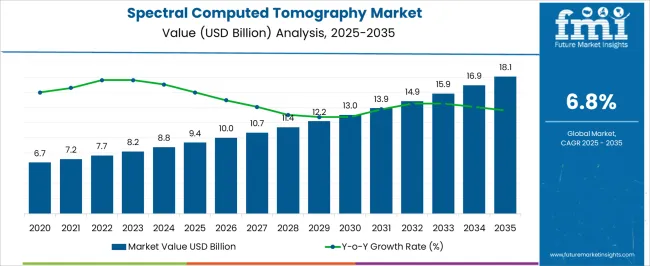
| Metric | Value |
|---|---|
| Spectral Computed Tomography Market Estimated Value in (2025 E) | USD 9.4 billion |
| Spectral Computed Tomography Market Forecast Value in (2035 F) | USD 18.1 billion |
| Forecast CAGR (2025 to 2035) | 6.8% |
The spectral computed tomography market is advancing steadily, driven by increasing clinical adoption of imaging modalities that provide enhanced diagnostic accuracy and greater tissue characterization. The technology is being widely recognized for its ability to differentiate materials based on spectral data, offering superior contrast resolution compared to conventional CT systems. Hospitals and diagnostic centers are investing in these systems to improve detection of cardiovascular diseases, oncology conditions, and neurological disorders.
The growing emphasis on precision medicine and early disease detection is reinforcing the use of spectral CT across a wide range of diagnostic procedures. Technological progress, including the integration of advanced detectors and AI-driven reconstruction algorithms, is making systems more efficient and adaptable for complex clinical requirements.
Rising healthcare expenditure in both developed and emerging economies, combined with the demand for reduced radiation dose and improved patient outcomes, is creating a strong foundation for market growth As the healthcare industry moves toward personalized care, spectral CT is expected to play a central role in supporting advanced clinical decision-making and treatment planning.
The spectral computed tomography market is segmented by application areas, product type, technology, end-user, and geographic regions. By application areas, spectral computed tomography market is divided into Medical Imaging Device, Oncology, Body Imaging, Cardiology, Neurology, Spine, Urology, Musculoskeletal Disorders, Others, Industrial, Electronics, Oil And Gas, and Automotive And Transportation. In terms of product type, spectral computed tomography market is classified into Multi-Slice Computed Tomography, Spiral Ct, and Electron Beam Tomography. Based on technology, spectral computed tomography market is segmented into Dual-Layer Detector and Gemstone Spectral Imaging Detector. By end-user, spectral computed tomography market is segmented into Hospitals, Private Clinics, Diagnostic And Imaging Centers, Academic Institutes And Research Centers, and Others. Regionally, the spectral computed tomography industry is classified into North America, Latin America, Western Europe, Eastern Europe, Balkan & Baltic Countries, Russia & Belarus, Central Asia, East Asia, South Asia & Pacific, and the Middle East & Africa.
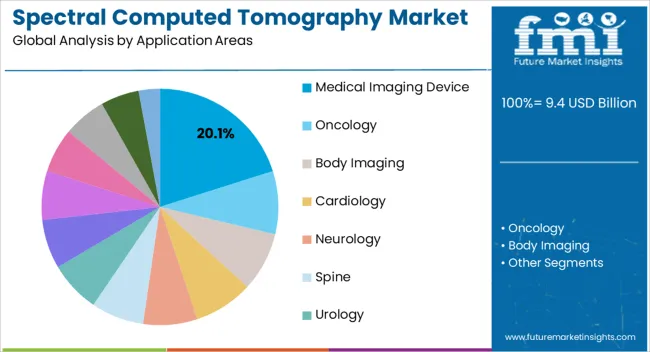
The medical imaging device segment is projected to account for 20.1% of the spectral computed tomography market revenue share in 2025, making it the leading application area. This dominance is being driven by the increased demand for diagnostic imaging solutions that can provide detailed anatomical and functional insights in a single scan. Spectral CT devices are being integrated into hospitals and imaging centers to support improved diagnostic workflows for complex diseases, including oncology, cardiovascular disorders, and neurological conditions.
The segment’s growth is further reinforced by the ability of spectral CT systems to reduce the number of follow-up imaging procedures, which enhances efficiency and lowers costs for healthcare providers. The rising incidence of chronic diseases and the emphasis on early and accurate diagnosis are propelling the adoption of these devices.
Healthcare providers are increasingly prioritizing imaging platforms that balance diagnostic accuracy with patient safety through dose reduction technologies As medical imaging continues to evolve into a cornerstone of precision healthcare, spectral CT devices are positioned to maintain their leadership role in clinical adoption.
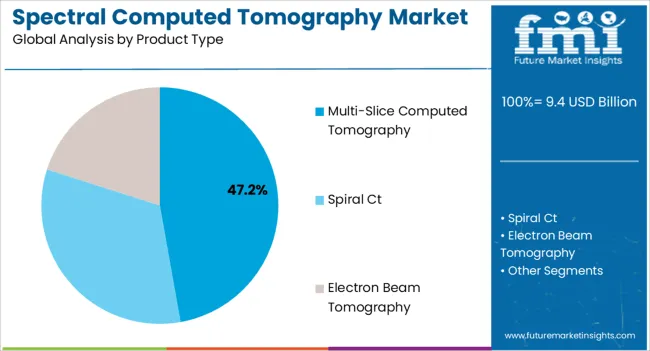
The multi-slice computed tomography product type is expected to hold 47.2% of the spectral computed tomography market revenue share in 2025, securing its position as the leading product type. This leadership is being reinforced by the system’s capability to capture high-resolution images rapidly, enabling faster diagnostic turnaround and improved patient throughput. Multi-slice systems support simultaneous imaging of multiple cross-sections, which significantly enhances diagnostic accuracy and allows clinicians to assess complex structures with greater clarity.
The segment’s dominance is further strengthened by its adaptability in a wide range of clinical applications, from routine imaging to advanced oncology and cardiovascular studies. Hospitals and imaging centers are prioritizing multi-slice systems due to their ability to accommodate large patient volumes while ensuring precision.
Continuous advancements in detector design and software-driven image reconstruction are also elevating performance standards As healthcare facilities seek versatile and cost-efficient imaging solutions, multi-slice computed tomography systems are expected to retain their strong market position, supported by their proven ability to deliver superior diagnostic outcomes across diverse patient populations.
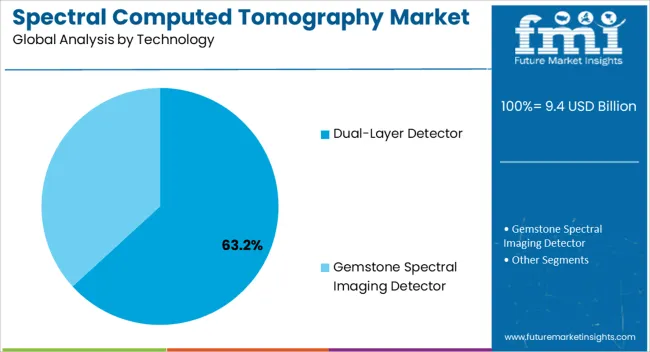
The dual-layer detector technology segment is projected to represent 63.2% of the spectral computed tomography market revenue share in 2025, making it the dominant technology. This leadership is being supported by the unique ability of dual-layer detectors to simultaneously capture high- and low-energy data, enabling improved material differentiation and tissue characterization without the need for additional scans. The efficiency of this technology reduces radiation exposure while enhancing diagnostic confidence, which is increasingly important for patient safety and compliance with regulatory standards.
Hospitals and diagnostic facilities are adopting dual-layer systems to achieve more accurate detection of subtle lesions, vascular conditions, and tumor characterization. The segment’s growth is further reinforced by its ability to streamline clinical workflows, reduce imaging artifacts, and provide more consistent diagnostic results across varied patient groups.
Continuous innovation in detector sensitivity and integration with advanced imaging algorithms is ensuring superior image quality As demand rises for advanced diagnostic technologies that combine safety, speed, and precision, dual-layer detector technology is expected to remain the cornerstone of spectral CT adoption worldwide.
Spectral Computed Tomography is a scanning technique unlike conventional computed tomography it separates the energy into two or more narrow energy bands instead of using one broad energy band of x-rays. Energy bands are absorbed differently by different body tissues. Introduction of spectral computed tomography has revolutionized the diagnostic system by offering radiologists more clear view over any type of discrepancy in body organs.
The exclusivity and preciseness of spectral computed tomography proved them to be a useful and reliable tool for radiologists around the globe. Spectral computed tomography is able to perform image acquisition and processing at multiple energy levels, which are to improving visualization than conventional CT and providing urgent diagnosis for disorders having large prevalence these days such as aneurysm, cancer, tumor, cardiovascular impairment and disease related to bones.
The demand for spectral tomography foreseen to increase on the back drop of rising healthcare expenditure in the economies worldwide. Furthermore, in some cases for accurate diagnosis a contrast agent is administered intravenously prior to the scan, the drug or the agent dose used is comparatively lower than the dose used in conventional CT scans. Besides, easy availability of conventional x-ray imaging system’s and its cost the spectral tomography is gaining popularity and as a result adoption is anticipated to increase in the near future.
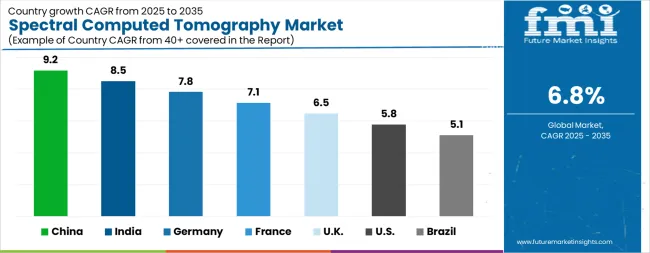
| Country | CAGR |
|---|---|
| China | 9.2% |
| India | 8.5% |
| Germany | 7.8% |
| France | 7.1% |
| UK | 6.5% |
| USA | 5.8% |
| Brazil | 5.1% |
The Spectral Computed Tomography Market is expected to register a CAGR of 6.8% during the forecast period, exhibiting varied country level momentum. China leads with the highest CAGR of 9.2%, followed by India at 8.5%. Developed markets such as Germany, France, and the UK continue to expand steadily, while the USA is likely to grow at consistent rates. Brazil posts the lowest CAGR at 5.1%, yet still underscores a broadly positive trajectory for the global Spectral Computed Tomography Market. In 2024, Germany held a dominant revenue in the Western Europe market and is expected to grow with a CAGR of 7.8%. The USA Spectral Computed Tomography Market is estimated to be valued at USD 3.2 billion in 2025 and is anticipated to reach a valuation of USD 5.7 billion by 2035. Sales are projected to rise at a CAGR of 5.8% over the forecast period between 2025 and 2035. While Japan and South Korea markets are estimated to be valued at USD 453.9 million and USD 273.2 million respectively in 2025.
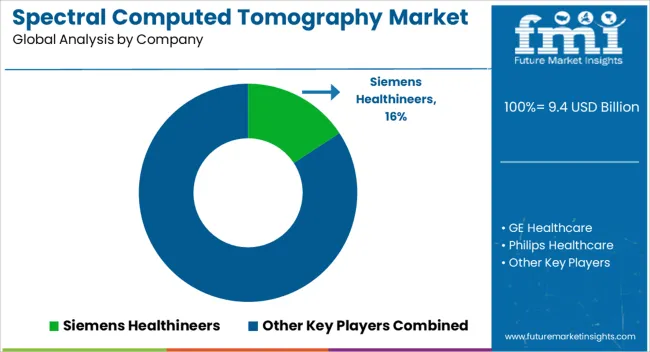
| Item | Value |
|---|---|
| Quantitative Units | USD 9.4 Billion |
| Application Areas | Medical Imaging Device, Oncology, Body Imaging, Cardiology, Neurology, Spine, Urology, Musculoskeletal Disorders, Others, Industrial, Electronics, Oil And Gas, and Automotive And Transportation |
| Product Type | Multi-Slice Computed Tomography, Spiral Ct, and Electron Beam Tomography |
| Technology | Dual-Layer Detector and Gemstone Spectral Imaging Detector |
| End-User | Hospitals, Private Clinics, Diagnostic And Imaging Centers, Academic Institutes And Research Centers, and Others |
| Regions Covered | North America, Europe, Asia-Pacific, Latin America, Middle East & Africa |
| Country Covered | United States, Canada, Germany, France, United Kingdom, China, Japan, India, Brazil, South Africa |
| Key Companies Profiled | Siemens Healthineers, GE Healthcare, Philips Healthcare, Canon Medical Systems, Hitachi Medical Systems, Toshiba Medical Systems (now Canon), Samsung Medison, Hologic Inc., Fujifilm Holdings Corporation, and Agfa-Gevaert Group |
The global spectral computed tomography market is estimated to be valued at USD 9.4 billion in 2025.
The market size for the spectral computed tomography market is projected to reach USD 18.1 billion by 2035.
The spectral computed tomography market is expected to grow at a 6.8% CAGR between 2025 and 2035.
The key product types in spectral computed tomography market are medical imaging device, oncology, body imaging, cardiology, neurology, spine, urology, musculoskeletal disorders, others, industrial, electronics, oil and gas and automotive and transportation.
In terms of product type, multi-slice computed tomography segment to command 47.2% share in the spectral computed tomography market in 2025.
Explore Similar Insights

Thank you!
You will receive an email from our Business Development Manager. Please be sure to check your SPAM/JUNK folder too.
Chat With
MaRIA